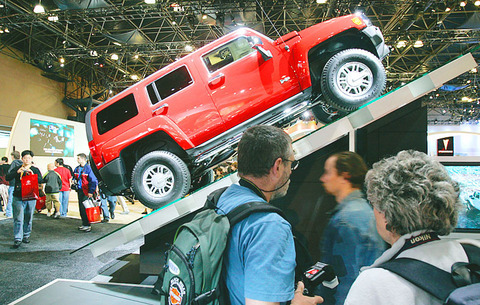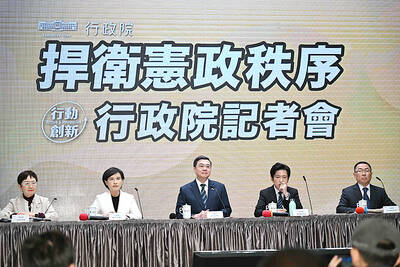Automakers seem to be a little frantic these days. At this season's major auto shows in Detroit, Chicago, Geneva and New York, they offered vehicles powered by diesel fuel, hybrid systems and ethanol, massive pickups and tiny subcompacts, nostalgic muscle cars and futuristic crossovers.
Finding the right formula to whet car buyers' appetites has become more essential than ever. Automakers are responding with more products to fill every niche, which is a boon for consumers but painful and expensive for US automakers.
High gasoline prices also intensify the risks for General Motors Corp and Ford Motor Co, whose operating profits come primarily from less-fuel-efficient pickup trucks and sport utility vehicles.

PHOTO: AP
"There's a lot of things GM and Ford are still grappling with if they're going to adapt to these niche markets," said Erich Merkle, director of forecasting for the consulting firm IRN Inc. "They can be profitable, but they're going to have to change the entire way they do business."
In a recent speech, Ford's Americas president Mark Fields said there will be 300 nameplates in the US market by the end of the decade, up from 215 in 2002. The explosion is apparent at the auto shows. In Detroit alone, 33 vehicles made their worldwide debuts.
Japanese and South Korean automakers are better equipped to make many different models because they have lower labor costs and newer, more flexible plants that can build multiple products on the same line.
When Honda Motor Co found its Ridgeline pickup was not meeting sales targets, it ramped up production of more popular vehicles like the Odyssey minivan made at the same plant, Merkle said.
Ford and GM are working on making their operations leaner, by cutting thousands of jobs, closing plants, and using the same underpinnings on multiple vehicles, but it will take time before they can match the level of their rivals.
Fields said this past week that Ford expects 82 percent of its assembly facilities to be flexible by 2008, up from 38 percent in 2004.
Meanwhile, they'll be facing a product juggernaut from more nimble companies. At the New York show last week, Hyundai Motor Co launched its seventh totally redesigned product in 24 months.
"There seems to be something for everyone. Automakers are slicing the pie even narrower," said Jack Nerad, editorial director of Kelley Blue Book, an auto information service, as he roamed the New York show, which opened to the public on Friday.
Against a backdrop of high gas prices, fuel-saving technologies were big at this year's shows. Jim Sanfilippo, a senior industry analyst with Michigan-based Automotive Marketing Consultants Inc, said the hybrid-electric system on the new Lexus LS600h is one of the most advanced inventions he has ever seen.
The 600h, which debuted at the New York show and goes on sale next year, is billed as a luxury performance sedan, with a V8 engine that performs more like a 12-cylinder when it's coupled with hybrid-electric power.
But Nerad said it's uncertain if high-performance hybrids will catch on with consumers, who are not accustomed to viewing hybrids as horsepower boosters. It's a debate that highlights the risk for automakers in a time of rapidly changing technology.
That's why automakers are placing bets on different technology. In Detroit, Ford rolled out a diesel-electric hybrid concept that it says can achieve 104km per gallon. Mercedes-Benz promoted its Bluetec diesel engine, which will meet emissions regulations in all 50 US states once ultra-low-sulfur diesel comes on the market this fall. Vehicles powered by corn-based ethanol got an unusual amount of attention as a viable technology that's already on the road.
At the Chicago show, GM and Ford announced plans to convert more fuel pumps to ethanol and educate the owners of the 6 million ethanol-capable vehicles on the road about the benefits of the fuel, which contains only 15 percent gasoline.

The US government has signed defense cooperation agreements with Japan and the Philippines to boost the deterrence capabilities of countries in the first island chain, a report by the National Security Bureau (NSB) showed. The main countries on the first island chain include the two nations and Taiwan. The bureau is to present the report at a meeting of the legislature’s Foreign Affairs and National Defense Committee tomorrow. The US military has deployed Typhon missile systems to Japan’s Yamaguchi Prefecture and Zambales province in the Philippines during their joint military exercises. It has also installed NMESIS anti-ship systems in Japan’s Okinawa

‘WIN-WIN’: The Philippines, and central and eastern European countries are important potential drone cooperation partners, Minister of Foreign Affairs Lin Chia-lung said Minister of Foreign Affairs Lin Chia-lung (林佳龍) in an interview published yesterday confirmed that there are joint ventures between Taiwan and Poland in the drone industry. Lin made the remark in an exclusive interview with the Chinese-language Liberty Times (the Taipei Times’ sister paper). The government-backed Taiwan Excellence Drone International Business Opportunities Alliance and the Polish Chamber of Unmanned Systems on Wednesday last week signed a memorandum of understanding in Poland to develop a “non-China” supply chain for drones and work together on key technologies. Asked if Taiwan prioritized Poland among central and eastern European countries in drone collaboration, Lin

BACK TO WORK? Prosecutors said they are considering filing an appeal, while the Hsinchu City Government said it has applied for Ann Kao’s reinstatement as mayor The High Court yesterday found suspended Hsinchu mayor Ann Kao (高虹安) not guilty of embezzling assistant fees, reducing her sentence to six months in prison commutable to a fine from seven years and four months. The verdict acquitted Kao of the corruption charge, but found her guilty of causing a public official to commit document forgery. The High Prosecutors’ Office said it is reviewing the ruling and considering whether to file an appeal. The Taipei District Court in July last year sentenced Kao to seven years and four months in prison, along with a four-year deprivation of civil rights, for contravening the Anti-Corruption

NO CONFIDENCE MOTION? The premier said that being toppled by the legislature for defending the Constitution would be a democratic badge of honor for him Premier Cho Jung-tai (卓榮泰) yesterday announced that the Cabinet would not countersign the amendments to the local revenue-sharing law passed by the Legislative Yuan last month. Cho said the decision not to countersign the amendments to the Act Governing the Allocation of Government Revenues and Expenditures (財政收支劃分法) was made in accordance with the Constitution. “The decision aims to safeguard our Constitution,” he said. The Constitution stipulates the president shall, in accordance with law, promulgate laws and issue mandates with the countersignature of the head of the Executive Yuan, or with the countersignatures of both the head of the Executive Yuan and ministers or